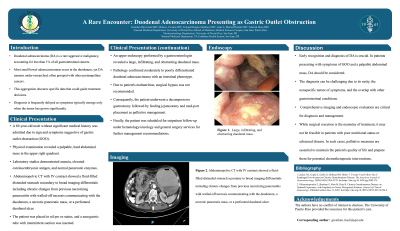Monday Poster Session
Category: Small Intestine
P3261 - A Rare Encounter: Duodenal Adenocarcinoma Presenting as Gastric Outlet Obstruction
Monday, October 28, 2024
10:30 AM - 4:00 PM ET
Location: Exhibit Hall E

Has Audio

Gretchen Rios, MD
University of Puerto Rico, Medical Sciences Campus
San Juan, PR
Presenting Author(s)
Gretchen Rios Grant, MD1, Viviana Blanco, MD2, Lidynell Burgos, MD1, Jesus Merced, MD3, Marcel Mesa, MD1
1University of Puerto Rico, Medical Sciences Campus, San Juan, Puerto Rico; 2University of Puerto Rico Medical Sciences Campus, Coto Laurel, Puerto Rico; 3VA Caribbean Healthcare System, San Juan, Puerto Rico
Introduction: Duodenal adenocarcinoma (DA) is a rare aggressive malignancy, accounting for less than 1% of all gastrointestinal cancers. Most small bowel adenocarcinomas occur in the duodenum, yet DA remains under-researched; often grouped with other periampullary cancers. This aggregation obscures specific data that could guide treatment decisions. Diagnosis is frequently delayed as symptoms typically emerge only when the tumor has grown significantly.
Case Description/Methods: A 69-year-old male without significant medical history was admitted due to sign and symptoms suggestive of gastric outlet obstruction (GOO). Physical examination revealed a palpable, hard abdominal mass in the upper right quadrant. Laboratory studies demonstrated anemia, elevated carcinoembryonic antigen, and normal pancreatic enzymes. Abdominopelvic CT with IV contrast showed a fluid-filled distended stomach secondary to broad imaging differentials including chronic changes from previous necrotizing pancreatitis with walled-off necrosis communicating with the duodenum, a necrotic pancreatic mass, or a perforated duodenal ulcer. The patient was placed in nil per os status, and a nasogastric tube with intermittent suction was inserted. An upper endoscopy performed by a gastroenterologist revealed a large, infiltrating, and obstructing duodenal mass. Pathology confirmed moderately to poorly differentiated duodenal adenocarcinoma with an intestinal phenotype. Due to patient's malnutrition, surgical bypass was not recommended. Consequently, the patient underwent a decompressive gastrostomy followed by feeding jejunostomy and med-port placement as palliative management. Finally, the patient was scheduled for outpatient follow-up under hematology/oncology and general surgery services for further management recommendations.
Discussion: Early recognition and diagnosis of DA is crucial. In patients presenting with symptoms of GOO and a palpable abdominal mass, DA should be considered. The diagnosis can be challenging due to its rarity, the nonspecific nature of symptoms, and the overlap with other gastrointestinal conditions. Comprehensive imaging and endoscopic evaluation are critical for diagnosis and management. While surgical resection is the mainstay of treatment, it may not be feasible in patients with poor nutritional status or advanced disease. In such cases, palliative measures are essential to maintain the patient's quality of life and prepare them for potential chemotherapeutic interventions.
Disclosures:
Gretchen Rios Grant, MD1, Viviana Blanco, MD2, Lidynell Burgos, MD1, Jesus Merced, MD3, Marcel Mesa, MD1. P3261 - A Rare Encounter: Duodenal Adenocarcinoma Presenting as Gastric Outlet Obstruction, ACG 2024 Annual Scientific Meeting Abstracts. Philadelphia, PA: American College of Gastroenterology.
1University of Puerto Rico, Medical Sciences Campus, San Juan, Puerto Rico; 2University of Puerto Rico Medical Sciences Campus, Coto Laurel, Puerto Rico; 3VA Caribbean Healthcare System, San Juan, Puerto Rico
Introduction: Duodenal adenocarcinoma (DA) is a rare aggressive malignancy, accounting for less than 1% of all gastrointestinal cancers. Most small bowel adenocarcinomas occur in the duodenum, yet DA remains under-researched; often grouped with other periampullary cancers. This aggregation obscures specific data that could guide treatment decisions. Diagnosis is frequently delayed as symptoms typically emerge only when the tumor has grown significantly.
Case Description/Methods: A 69-year-old male without significant medical history was admitted due to sign and symptoms suggestive of gastric outlet obstruction (GOO). Physical examination revealed a palpable, hard abdominal mass in the upper right quadrant. Laboratory studies demonstrated anemia, elevated carcinoembryonic antigen, and normal pancreatic enzymes. Abdominopelvic CT with IV contrast showed a fluid-filled distended stomach secondary to broad imaging differentials including chronic changes from previous necrotizing pancreatitis with walled-off necrosis communicating with the duodenum, a necrotic pancreatic mass, or a perforated duodenal ulcer. The patient was placed in nil per os status, and a nasogastric tube with intermittent suction was inserted. An upper endoscopy performed by a gastroenterologist revealed a large, infiltrating, and obstructing duodenal mass. Pathology confirmed moderately to poorly differentiated duodenal adenocarcinoma with an intestinal phenotype. Due to patient's malnutrition, surgical bypass was not recommended. Consequently, the patient underwent a decompressive gastrostomy followed by feeding jejunostomy and med-port placement as palliative management. Finally, the patient was scheduled for outpatient follow-up under hematology/oncology and general surgery services for further management recommendations.
Discussion: Early recognition and diagnosis of DA is crucial. In patients presenting with symptoms of GOO and a palpable abdominal mass, DA should be considered. The diagnosis can be challenging due to its rarity, the nonspecific nature of symptoms, and the overlap with other gastrointestinal conditions. Comprehensive imaging and endoscopic evaluation are critical for diagnosis and management. While surgical resection is the mainstay of treatment, it may not be feasible in patients with poor nutritional status or advanced disease. In such cases, palliative measures are essential to maintain the patient's quality of life and prepare them for potential chemotherapeutic interventions.
Disclosures:
Gretchen Rios Grant indicated no relevant financial relationships.
Viviana Blanco indicated no relevant financial relationships.
Lidynell Burgos indicated no relevant financial relationships.
Jesus Merced indicated no relevant financial relationships.
Marcel Mesa indicated no relevant financial relationships.
Gretchen Rios Grant, MD1, Viviana Blanco, MD2, Lidynell Burgos, MD1, Jesus Merced, MD3, Marcel Mesa, MD1. P3261 - A Rare Encounter: Duodenal Adenocarcinoma Presenting as Gastric Outlet Obstruction, ACG 2024 Annual Scientific Meeting Abstracts. Philadelphia, PA: American College of Gastroenterology.
